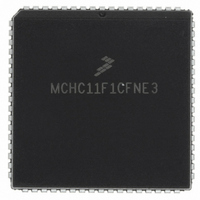MCHC11F1CFNE3 Freescale Semiconductor, MCHC11F1CFNE3 Datasheet - Page 31

MCHC11F1CFNE3
Manufacturer Part Number
MCHC11F1CFNE3
Description
IC MCU 8BIT 1K RAM 68-PLCC
Manufacturer
Freescale Semiconductor
Series
HC11r
Specifications of MCHC11F1CFNE3
Core Processor
HC11
Core Size
8-Bit
Speed
3MHz
Connectivity
SCI, SPI
Peripherals
POR, WDT
Number Of I /o
30
Program Memory Type
ROMless
Eeprom Size
512 x 8
Ram Size
1K x 8
Voltage - Supply (vcc/vdd)
4.75 V ~ 5.25 V
Data Converters
A/D 8x8b
Oscillator Type
Internal
Operating Temperature
-40°C ~ 85°C
Package / Case
68-PLCC
A/d Inputs
8-Channel, 8-Bit
Eeprom Memory
512 Bytes
Input Output
30
Interface
SCI/SPI
Memory Type
EPROM
Number Of Bits
8
Package Type
68-pin PLCC
Programmable Memory
0 Bytes
Timers
3-16-bit
Voltage, Range
3-5.5 V
Controller Family/series
68HC11
No. Of I/o's
30
Eeprom Memory Size
512Byte
Ram Memory Size
1KB
Cpu Speed
3MHz
No. Of Timers
1
Embedded Interface Type
SCI, SPI
Rohs Compliant
Yes
Processor Series
HC11F
Core
HC11
Data Bus Width
8 bit
Program Memory Size
512 B
Data Ram Size
1 KB
Interface Type
SCI, SPI
Maximum Clock Frequency
3 MHz
Number Of Timers
1
Maximum Operating Temperature
+ 85 C
Mounting Style
SMD/SMT
Minimum Operating Temperature
- 40 C
On-chip Adc
8 bit, 8 Channel
Lead Free Status / RoHS Status
Lead free / RoHS Compliant
Program Memory Size
-
Lead Free Status / Rohs Status
RoHS Compliant part
Available stocks
Company
Part Number
Manufacturer
Quantity
Price
Company:
Part Number:
MCHC11F1CFNE3
Manufacturer:
FREESCALE
Quantity:
5 530
Company:
Part Number:
MCHC11F1CFNE3
Manufacturer:
FREESCALE
Quantity:
5 530
Company:
Part Number:
MCHC11F1CFNE3
Manufacturer:
Freescale Semiconductor
Quantity:
10 000
Company:
Part Number:
MCHC11F1CFNE3R
Manufacturer:
Freescale Semiconductor
Quantity:
10 000
3.1.6.8 Stop Disable (S)
3.2 Data Types
3.3 Opcodes and Operands
3.4 Addressing Modes
3.4.1 Immediate
TECHNICAL DATA
Setting the STOP disable (S) bit prevents the STOP instruction from putting the
M68HC11 into a low-power stop condition. If the CPU encounters a STOP instruction
while the S bit is set, it is treated as a no-operation (NOP) instruction, and processing
continues to the next instruction. S is set by reset — STOP disabled by default.
The M68HC11 CPU supports the following data types:
A byte is eight bits wide and can be accessed at any byte location. A word is composed
of two consecutive bytes with the most significant byte at the lower value address. Be-
cause the M68HC11 is an 8-bit CPU, there are no special requirements for alignment
of instructions or operands.
The M68HC11 family of microcontrollers uses 8-bit opcodes. Each opcode identifies
a particular instruction and associated addressing mode to the CPU. Several opcodes
are required to provide each instruction with a range of addressing capabilities. Only
256 opcodes would be available if the range of values were restricted to the number
able to be expressed in 8-bit binary numbers.
A four-page opcode map has been implemented to expand the number of instructions.
An additional byte, called a prebyte, directs the processor from page 0 of the opcode
map to one of the other three pages. As its name implies, the additional byte precedes
the opcode.
A complete instruction consists of a prebyte, if any, an opcode, and zero, one, two, or
three operands. The operands contain information the CPU needs for executing the
instruction. Complete instructions can be from one to five bytes long.
Six addressing modes can be used to access memory: immediate, direct, extended,
indexed, inherent, and relative. These modes are detailed in the following paragraphs.
All modes except inherent mode use an effective address. The effective address is the
memory address from which the argument is fetched or stored, or the address from
which execution is to proceed. The effective address can be specified within an in-
struction, or it can be calculated.
In the immediate addressing mode an argument is contained in the byte(s) immediate-
ly following the opcode. The number of bytes following the opcode matches the size
of the register or memory location being operated on. There are two-, three-, and four-
• Bit data
• 8-bit and 16-bit signed and unsigned integers
• 16-bit unsigned fractions
• 16-bit addresses
Freescale Semiconductor, Inc.
For More Information On This Product,
CENTRAL PROCESSING UNIT
Go to: www.freescale.com
3-7











